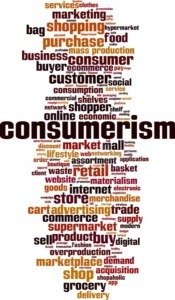
DR. PRADEEP SALGAONKAR shares his thoughts on consumerism and explains what it means for the consumers and marketers

There are two perspectives to consumerism; one, as consumer rights, i.e. the protection or promotion of the interests of consumers, and two, as increase in consumption and materialism i.e. the propensity to consume and keep consuming.
As consumer rights: Consumerism is considered as a modern movement for protection of the consumer against fake, spurious, inferior, or dangerous products, misleading advertising, unfair pricing; etc. It is a protest of consumers against unfair business practices and business injustices. Consumerism is a social force designed to protect consumer interests in the marketplace by sensitising and bringing consumers together to build consumer pressures on business and seek justice. The force and the movement aims to remove injustices, and eliminate unfair marketing practices, e.g., adulteration, spurious products, unsafe products, poor quality products, fictitious pricing, price collusion, deceptive packaging, misbranding, false and misleading advertisements, defective warranties, hoarding, profiteering, black marketing, short weights and measures, planned obsolescence, etc.
As increase in consumption: Consumerism encourages the acquisition of goods and services in ever-increasing amounts. It is a belief that it is good to buy and use a lot of goods, or it is a self-propelled drive to buy and own more stuff, and to define one’s identity through what they own. It is a socio-economic activity that is based on the continuous consumption of goods and services. In other words, consumerism encourages people to buy and use more goods and services than they actually need. Consumerism is also understood as a cultural and economic ideology that emphasises the importance of purchasing goods and services for personal satisfaction and happiness. This ideology promotes the idea that increasing consumption of goods and services leads to greater personal and societal well-being and contribution to the nation’s economic growth.
Drivers of consumerism
Consumerism is driven by a combination of factors, including the availability of consumer goods, the growth of advertising, and the rise of consumer credit. A humongous rise in advertising on every possible platform is used to create a demand for goods by appealing to people’s desires and emotions. Advertisers use a variety of techniques, including product placement, celebrity endorsements, and persuasive messages, to encourage people to buy more goods. This helps to create a culture of consumerism, where people are encouraged to buy more goods for their own pleasure and to keep up with their neighbours.
The history of consumerism can be traced back to the late 19th century, when the industrial revolution and the growth of mass production led to a significant increase in the availability of goods. This increase in goods created a new market for consumer goods and helped to spur the growth of consumer culture. During the early 20th century, consumerism continued to grow, as the availability of consumer goods increased and the purchasing power of people grew, so also the middle class grew manifold. The growth of consumerism was also encouraged by government policies, such as the creation of consumer protection laws, which helped to create a supportive environment for consumer culture.
During the mid-20th century, consumerism became more widespread and deeply ingrained in society. The growth of mass media, such as television, helped to spread the message of consumerism, and the availability of consumer goods continued to increase. Additionally, the growth of consumerism was fuelled by the economic boom, which created a new market for consumer goods.
Consumerism in India has grown rapidly in recent years, due to the country’s strong economic growth and increasing purchasing power of its citizens. India has become a major market for both domestic and international companies, as consumers in India have embraced the concept of buying and consuming more goods and services than they actually need. This trend has been fuelled by the growth of the middle class, changing expectations and needs, higher disposable income in hand coupled with the increasing availability of consumer credit, which has made it easier for people to buy goods on credit. Thus, consumerism is becoming a way of life for people today.
Besides the above factors, there are a few major changes that have taken place globally which have changed the landscape and drive for consumerism. There are ten conspicuous changes globally which contribute directly to the rise in consumerism. These ten forces are: exponential rise in mobile and internet use, inappropriate content consumption, influence and behaviour of the impactful Gen Y (millennial) and Gen Z population, increase in online shopping, the startup boom and availability of more variety and choice to consumers and easy shipment of goods via D2C channels, Big Data – the new fuel and use of the same by marketers to individually target customers and engage them, and use of AI for marketing and influencing consumer decision making.
Implications for the marketers
While the perspective of consumerism that, consumers consume more of goods and services beyond their requirement, is good for the marketers there is a need from the marketers side to work on the other side of the consumerism i.e. on the rights side of consumers or the consumer movements.
In recent years we have seen societal actions against so many advertising campaigns, in most cases forcing the advertisers to withdraw the campaigns, may it be Mahakal thali, Fab India, or Sabyaschi’s mangalsutra advertisement.
The root-cause of consumer movement or consumerism is ‘consumer dissonance’, i.e. after purchase doubts, dissatisfaction, disillusionment, disappointment. Present day consumer demands the following; Safety of products in all respects, Information – full and accurate – both before the purchase and after, wide choice of goods to meet every small and big need, and voice – complain and immediate satisfactory redress.
The trend today is that the consumer is a fully empowered consumer, having a high buying power and power to spend, coupled with a strong power to complain by way of social media. Thus, one can notice that the trend in the market has shifted from ‘Buyer Beware’ to ‘Seller Beware’.
According to management guru Peter Drucker, consumerism is ‘product-oriented marketing’. However, to make consumer protection or consumerism redundant, businesses will have to sincerely practice marketing concept, viz. ‘customer-oriented marketing’ philosophy. Be concerned and focused on the customer needs and expectations, do not give a single opportunity to the customer to get disappointed – from advertising to post consumption disposal of the product. Marketers better be aware that law is really not required today for consumers to call for action. Simply people power and awareness, coupled with power of social media can do the job. And that is what is happening today all over. The first voice of a disappointed customer goes on the social media. Individuals resort to social media for any of their grievances. Law thus remains as the last resort because it is costly and time consuming.
Thus, marketers in addition to being sensitive to sustainability aspects, environmental safeguard and protection and focus on promoting and protecting social equality, need to give a high preference to consumer choices, product information, complaints handling and prompt responsiveness. Consumerism is here to stay and only become more prominent in marketing.





